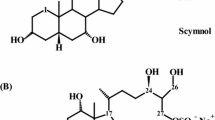Abstract
The potential role of sodium sulphate in possible enhancement of the hepatoprotective action of N-acetylcysteine (NAC) in paracetamol (PCM) overdose was examined. The effects of sodium sulphate (200 mg/kg) in combination with NAC (400 mg/kg) administered intraperitoneally 2 h post-PCM dose, on mortality rate and plasma activities of aspartate aminotransferase (AST) and alanine aminotransferase (ALT) were investigated in mice 24 h after receiving a single oral dose of 400 mg/kg PCM. In addition, the effect on the mortality rate of PCM-treated animals of co-administering 400 mg/kg sodium sulphate with NAC (200 or 400 mg/kg) was also studied. NAC alone caused a marked reduction in the mortality rate of PCM-treated mice and a sharp drop in their plasma AST and ALT activities to near normal values. However, no additional reduction in plasma levels of AST and ALT was observed when sodium sulphate was co-administered with NAC. Similarly, sodium sulphate (200 mg/kg) administered alone to PCM-treated mice had no effect on the high mortality rate or the elevation in plasma AST and ALT activities observed in these animals. Furthermore, increasing the dose of sodium sulphate to 400 mg/kg did not influence the mortality rate. It is therefore concluded that sodium sulphate neither protects against paracetamol-induced hepatotoxicity nor enhances the hepatoprotective action of N-acetylcysteine.
Similar content being viewed by others
References
Davidson DG, Eastham WN. Acute liver necrosis following overdose of paracetamol. Br Med J. 1966;2:497–9.
Prescott LF, Wright N, Roscoe P, Brown SS. Plasma paracetamol half-life and hepatic necrosis in patients with paracetamol overdose. Lancet. 1971;1:519–22.
Mitchell JR, Jollow DJ, Potter WZ, Davis DC, Gillette JR, Brodie BB. Acetaminophen-induced hepatic necrosis. I. Role of drug metabolism. J Pharmacol Exp Ther. 1973;187:185–94.
Jollow DJ, Mitchell JR, Potter WZ, Davis DC, Gillette JR, Brodie BB. Acetaminophen-induced necrosis. II. Role of covalent binding in vivo. J Pharmacol Exp Ther. 1973;187:195–202.
Hinson JA. Biochemical toxicology of acetaminophen. Rev Biochem Toxicol. 1980;2:103–29.
Prescott LF. Kinetics and metabolism of paracetamol and phenacetin. Br J Clin Pharm. 1980;10:291S-8S.
Prescott LF, Critchely JA. The treatment of acetaminophen poisoning. Ann Rev Pharmacol Toxicol. 1983;23:87–101.
Davis DC, Potter WZ, Jollow DJ, Mitchell JR. Species differences in hepatic glutathione depletion, covalent binding and hepatic necrosis after acetaminophen. Life Sci. 1974;14:2099–109.
Mitchell JR, Thorgeirsson SS, Potter WZ, Jollow DJ, Keiser H. Acetaminophen-induced hepatic injury: protective role of glutathione in man and rationale for therapy. Clin Pharmacol Ther. 1974;16:676–84.
Lauterburg BH, Corcoran GB, Mitchell JR. Mechanism of action of N-acetylcysteine in the protection against the hepatotoxicity of acetaminophen in rats in vivo. J Clin Invest 1983;71:980–91.
Corcoran GB, Todd EL, Racz WJ, Hughes H, Smith CV, Mitchell JR. Effects of N-acetylcysteine on the disposition and metabolism of acetaminophen in mice. J Pharmacol Exp Ther. 1985;232:857–63.
Peterson TC, Brown IR. Cysteamine in combination with N-acetylcysteine prevents acetaminophen-induced hepatotoxicity. Can J Physiol Pharmacol. 1992;70:20–8.
Slattery JT, Levy G. Acetaminophen kinetics in acutely poisoned patients. Clin Pharmacol Ther. 1979;25:184–95.
Slattery JT, Levy G. Reduction of acetaminophen toxicity by sodium sulfate in mice. Res Commun Chem Pathol Pharmacol. 1977;18:167–70.
Galinsky RE, Slattery JT, Levy G. Effect of sodium sulphate on acetaminophen elimination by rats. J Pharm Sci. 1979;68:803–5.
Galinsky RE, Levy G. Dose- and time-dependent elimination of acetaminophen in rats: pharmacokinetic implications of cosubstrate depletion. J Pharmacol Exp Ther. 1981;219:14–20.
Tredger JM, Thuluvath P, Williams R, Murray-Lyon IM. Metabolic basis for high paracetamol dosage without hepatic injury: a case study. Hum Exp Toxicol. 1995;14:8–12.
Prescott LF, Park J, Ballantyne A, Adriaenssens P, Proudfoot AT. Treatment of paracetamol (acetaminophen) poisoning with N-acetylcysteine. Lancet. 1977;2:432–4.
Smilkstein MJ, Bronstein AC, Linden C, Augenstein WL, Kulig KW, Rumack BH. Acetaminophen overdose: a 48-hour intravenous N-acetylcysteine treatment protocol. Ann Emerg Med. 1991;20:1058–63.
Mitchell MC, Schenker S, Speeg KV Jr. Selective inhibition of acetaminophen oxidation and toxicity by cimetidine and other histamine H2-receptor antagonists in vivo and in vitro in the rat and man. J Clin Invest. 1984;73:383–91.
Al-Mustafa ZH, Al-Ali AK, Qaw FS, Abdul-Cader Z. Cimetidine enhances the hepatoprotective action of N-acetylcysteine in mice treated with toxic doses of paracetamol. Toxicology. 1997;121:223–8.
Mitchell MC, Schenker S, Avant GR, Speeg KV Jr. Cimetidine protects against acetaminophen hepatotoxicity in rats. Gastroenterology. 1981;81:1052–60.
Abernethy DR, Greenblatt DJ, Divooll M, Ameer B, Shader RI. Differential effect of cimetidine on drug oxidation (antipyrine and diazepam) vs. conjugation (acetaminophen and lorazepam): prevention of acetaminophen toxicity by cimetidine. J Pharmacol Exp Ther. 1983;224:508–13.
Woo PCY, Kaan SK, Cho CH. Evidence for potential application of zinc as an antidote to acetaminophen-induced hepatotoxicity. Eur J Pharmacol Environ Toxicol Pharmacol Sect. 1995;293:217–24.
Author information
Authors and Affiliations
Rights and permissions
About this article
Cite this article
Al-Ali, A.K., Al-Mustafa, Z.H., Qaw, F.S. et al. Paracetamol-induced hepatotoxicity: Lack of enhancement of the hepatoprotective effect of N-acetylcysteine by sodium sulphate. Inflammopharmacol 6, 235–241 (1998). https://doi.org/10.1007/s10787-998-0022-4
Received:
Revised:
Accepted:
Issue Date:
DOI: https://doi.org/10.1007/s10787-998-0022-4




